Hyperautomation, composed of both established and emerging technologies, is becoming the standard among enterprise businesses aiming to accelerate productivity and profitability. However, unlike most technologies that center on a single or handful of isolated, non-portable platforms, softwares and task-automations, Hyperautomation is a collection of configured technologies and business processes aligned to create true end-to-end automation with minimal human intervention.
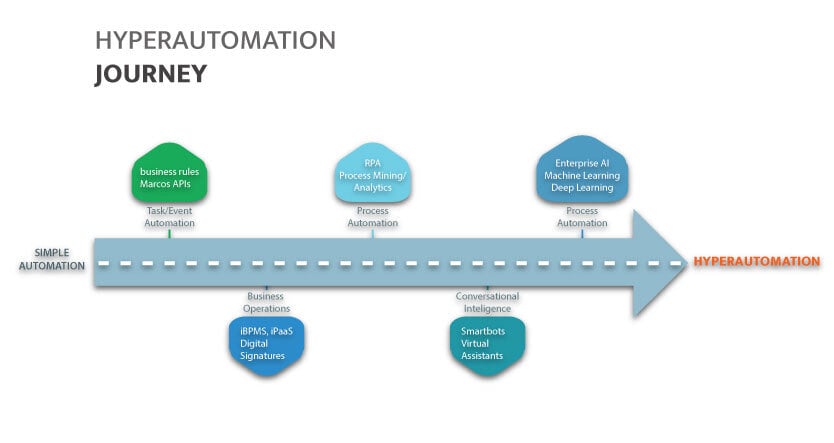
It is important to recognize that for maximum ROI and productivity, planning a sound execution strategy that reflects the unique needs and strengths of your business to create a set of productive, hyperautomated systems. These should ultimately reduce workforce resistance, streamline workflow and be portable across people and objectives.
To achieve this, keep the following insights in mind:
The simplest automation isn’t always the best
Enterprise businesses report failing to see benefits from previous automation effort due to the overtargeting of the most simple and repetitive processes, sacrificing high-ROI and long-term automation visions to grab low-hanging fruit. Whether this outcome is the result of internal politics or understandable desire to apply exciting technologies to mundane tasks, this trajectory can dampen progress towards a holistic end-to-end hyperautomation program that is increasingly becoming the competitive difference-maker.
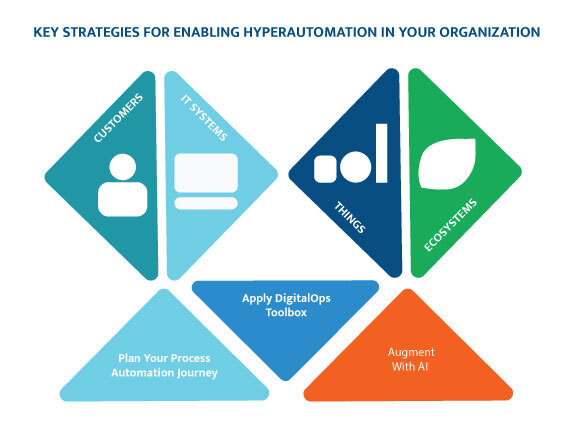
Hyperautomation is still a new concept
While a handful of companies like Cetrix are in the unique position to assist in enacting hyperautomation plans, there is currently an absence of accessible resources and personnel qualified to guide companies through the complexity of aligning RPA builds and deployment, Platform Integration, Decision Management Systems, and Process Mining with business objectives. Cetrix has the deepskills and experience to provide proactive, on-call, and hands-on consultation required formulate a workable plan and then execute it.
This is why aligning siloed AI to intelligent business processes to promote end-to-end automation requires an integrated strategy that also incorporates iPaas, APIs, low/no code modular frameworks across data lifecycles in order to turn insights into action. This requires deep skills across a range of disciplines.
Any actionable plan will follow the following steps that include defining desired business outcomes, optimizing processes, and configuring technologies in relation to business rules systems for streamlined and outcome-based, rather than task-focused workflows.
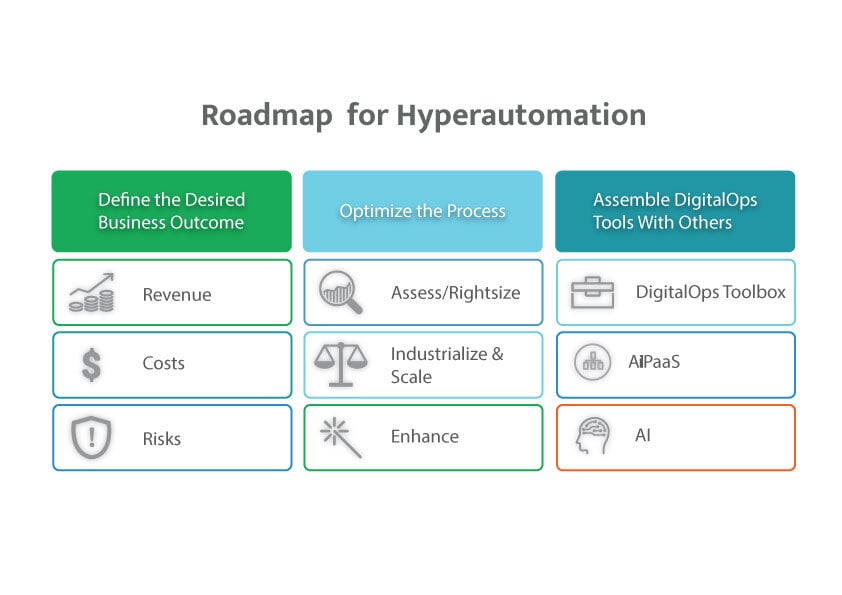
Selecting Business Outcomes
- Revenue: For any company, there are a number of areas to boost revenue. Enhance processes for greater efficiency, automate tasks, create opportunities for customer engagement or introduce new touchpoints/services
- Cost: Widen margins and reduce overhead by eliminating costly errors, reducing administrative burdens or allocating workforces.
- Reduce Risk: Do errors raise the risks of noncompliance, litigation or loss of revenue? Could you benefit from adherence to regulatory compliance that reduces reliance on hum decision making?
Use these perspectives to identify the use cases you wish to optimize in order to improve the efficiency of a customer-facing or internal business process. Use them to experiment with new ways of delivering value with customer service automation, CRM automation, or marketing automation, to name a few. Your roadmap should clearly distinguish your use cases and their outcomes associated with revenue, cost and risk goals.
Process Optimization
Choosing the right process to automate is key to internal adoption, ROI and later scaleability. Certain processes make better candidates for automation than others. But it is important to note that automating a bad process can generate bad, cost-sinking automation, and that automation alone won’t solve the bottlenecks and inefficiencies of a workflow.
■ Consider both the standard and unique aspects of a process and associated workflows to determine key points to automate, logical points of human intervention and connection to other automations.
■ Digitally industrialize core processes that drive products and services delivered via a digital business tool for both internal and customer-facing processes.
■ Enhancing your process with structured and standardized data inputs, and decision intelligence.
Activate your digital operations toolbox
For most companies hyperautomating, there are standard digital tools that reflect both agnostic and turnkey hyper automation solutions used for end-to-end automation. Some are required for the hyperautomation process while others are nice-haves. Assess different technology markets and create a step-by-step acquisition and deployment plan to effectively deliver precise tactical and holistic, business-wide value. Those considered necessary are BPMs, RPAs, Low/No code drag-and-drop process templating platforms, process mining and discovery analytics, Decision Management Suites/Business Rules Management Systems. Additional tools hyperautomated processes are APIs, ESBs (for legacy systems) and iPaaS are often used.
Business Process Management Systems
Quality Business process management suites provide key pieces of application infrastructures that support business projects and programs. A BPMs supports the entire process improvement life cycle, from process discovery, definition and design to implementation, monitoring and analysis, and continual process optimization.
Used to build and run workflows, the best tools in skilled hands have the flexibility and capacity to integrate your existing IT infrastructure and provide staging to design, test and optimize models from a unified and human-centric viewpoint.
Emerging (iBPMS) platforms carry a foundation of tools for orchestrating processes and automating tasks within those processes. iBPMS consolidate integration services, decision management, process orchestration, ad hoc processes and advanced analytics into a single platform.
In using BMP tools, focus on:
- Managing, mapping, rendering and optimizing with software all the components of a business process that includes people, machines, services and things, as well as functional boundaries between each.
- Triggering an RPA bot/script to automate a task within a process. You may use APIs to integrate the RPA scripts with your BPM master orchestrator.
- Monitoring metrics and creating/optimizing analytics dashboards to identify opportunities to improve the process.
■ Providing direct integration services/APIs to other enterprise platforms, applications and devices.
In choosing a BMPs, use the following criteria:
- User Interface (UI): Is the user interface updated, clean and user friendly; supporting rapid acquisition of the skills needed to use the platform and stress-free ongoing use?
- Customer Support: How comprehensive is the company’s tech support, user support, tutorials, and training?
- Features & Functionality: Does the platform contain a robust database for easy organizing, storage, search? Does it offer functionally to make said data useful, allowing it to capture and map key aspects of a process over the long term?
- Visual Workflow Modeling: Is there a way to easily design and edit a visual map of workflow processes? Can you toggle between model versions? Does it support drag-and-drop, keyboard shortcuts, and other quality-of-life implementations?
- Automation: Is the administrative requirement minimized by providing easily accessible pathways, permissions, functions and notifications?
- IT and non-IT integration: The concern here is two fold: Is functionality contained within allow for access and use by both IT and non-IT personale, and does it integrate easily with existing IT infrastructure.
- Integrations: Does the BMP software easily connect to other tools and allow for the easy transfer of data between old and new platforms? Perhaps most importantly, are there pre-built integrations that monitor business activity and allow for process mapping?
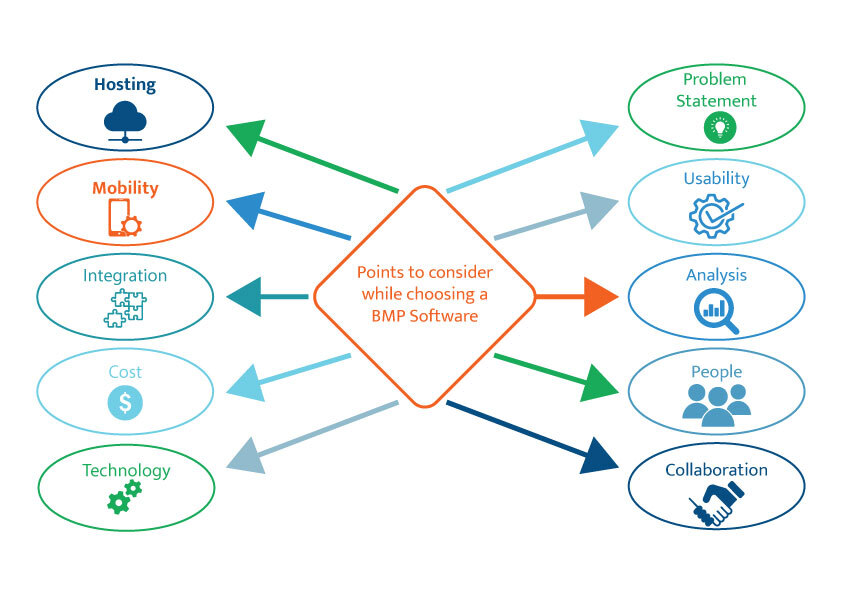
RPAs
RPAs are integration technologies that deploy software based robots designed to mimic human actions and are governed by blackbox, turnkey and custom scripts to automate routine, repetitive and predictable tasks though orachasted UI-based interaction.
Use RPA to focus on the following:
■ Identify ‘low-hanging’ automation fruit in the areas of marketing/sales, accounting, HR and customer services that not only allow for easy wins (ROI + Rapid Adoption + New Data Acquisition) but also set the stage for broader automation and hyperautomation.
■ Creating API facades with legacy applications to accelerate RPA integration and robust functionality. Building RPAs to interact with legacy applications where building traditional integration will be complex, time-consuming and expensive.
■ Transferring, cleaning and validating data from disparate sources in a large-scale ERP migration project.
■ Experimenting with a process prototypes by applying RPAs to perform quick proofs of concept before launching a new service or process.
Simply put up, RPAs put the ‘automation’ in hyperautomation. Questions around end-to-end process optimizing include by are not limited to RPA portability, scaling and optimization. It is common to confuse hyperautomation with this concept. However, understanding this core principle of automation and how to maximize its utility across a business that must consider the following questions:
How do I increase robotbotworkrates? Through volume and optimization of bot activity. Large numbers of RPA robots can work together to carry out a business process. Easily change which business process each of your robots is executing, letting them work on different processes at different times.
How do I expand usage scope? This aspect of scalability means support for broadening how and where RPA is used in an organization. You might start by automating a process in one part of your business and then expand by creating RPA solutions for processes in other departments.
How do I improve ease of access? Grant access for a higher number of people and process management points. Automated business processes often need to access new technologies, such as applications or integration platforms. This access can be viewed through a lens of scalability, because your RPA solutions will have additional use cases.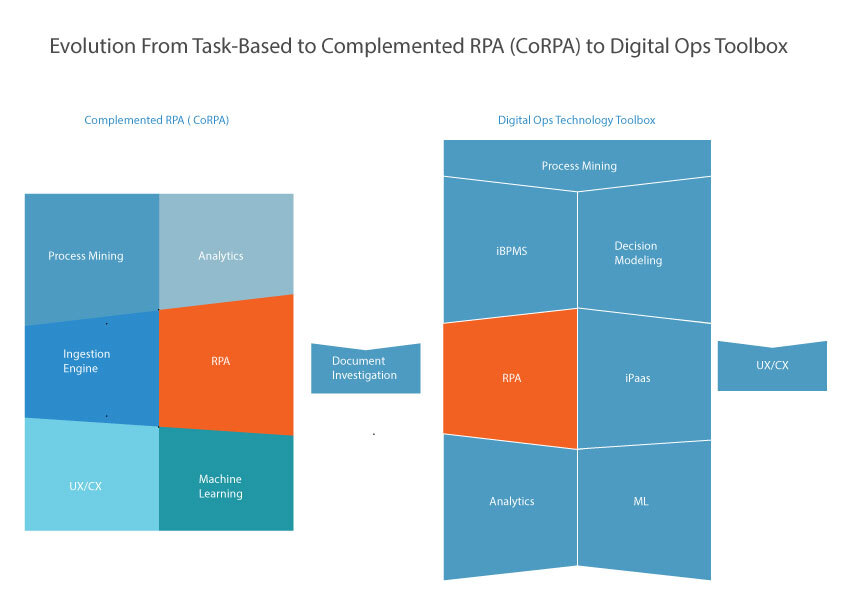
Low-Code Application Platforms
Low and No Code application platforms allow for the modeling and scaling of automated business processes, particularly when designed specifically to conduct end-to-end orchestration and workflows.
These turnkey development environments leverage drag-and-drop templating, out-of-box graphical interfaces for code abstraction. These platforms can be optimized for single operational situations or are open-ended to be used in a variety circumstances.
Advanced Low and No Code systems can allow for some degree of process modeling and optimization and should integrate with ERP and BPM systems with a variety of abstractions and visual/graphic representations.Apply Low Code Applications as a complementary tool to focus on the following:
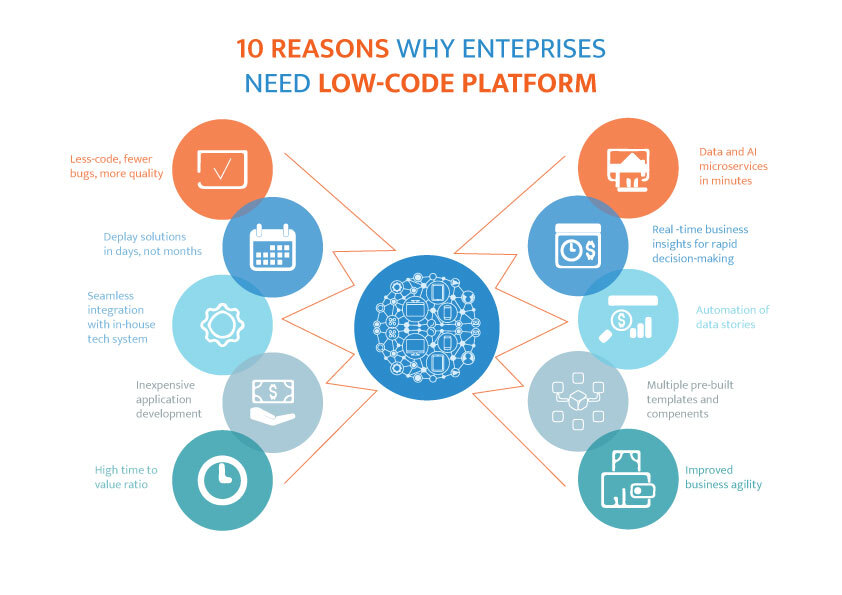
Aim to go rapidly from an idea to a deployed application is core to low code applications and are central to end-to-end automation with their flexibility, ease of use and integrative features. Automating a process that is small in scope, or changes frequently and is constrained to a single business function or team is a good place to start using Low Code builds.
■ The benefits to a Low or No Code Platforms go beyond code abstraction to the ability to visually and conceptually represent certain data and the processes that produce them. To this effect, many of these are multiexperience platforms.
■ Leveraging existing APIs for existing applications by using a broad set of pre-existing connectors to automate tasks. Keep in mind that the set of supported protocols for both agnostic and turnkey platforms can be limited compared to BPM suites so consider how the two might fit together. Most Low Code platforms focus on the most common RESTful APIs or common ERP systems.
Process Mining and Discovery
A more detailed overview of Process Mining can be found in our “What is Hyperventilation…” (Link) blog article. Process mining is designed to discover, monitor and improve real processes by extracting knowledge from the event logs readily available in application systems (see “Market Guide for Process Mining”). Process mining includes automated process discovery, conformance checking and other advanced analytics features.
Apply process mining tools to:
■ Identify process inefficiencies and they relationship to human inputs/outputs.
■ Uncover, monitor and configure tasks that can be automated by robots/scripts.
■ Capture data by highlighting events readily available on a workstation or various screens.
■ Create process documentation and autogeneration of simulated process models.
■ Implement, fix and expand model use.
■ Make process recommendations based on historical data.
You may integrate process mining tools with your BPM and RPA platforms to optimize routine automation opportunities by discovering, monitoring and analyzing business processes, tasks and interdependencies.
Decision Management Suites (DMSs)/Business Rules Management Systems (BRMSs)
DMSs are used to augment and support conventional application development when a business process includes decisions dictated by increasingly complicated or fluid logic. DMS products have evolved beyond basic business rule management systems by providing better support for analytics and decision modeling. These can be augmented by use alongside BPM tools. The best decision models are described in the context of goals, metrics, business processes, event triggers, systems and stakeholders.
A DMS is integral for decision-centric applications that involve any of the following:
■ Diverse kinds of data derived from multiple sources.
■ A high-volume of formalized business policies, implemented as rules and human-driven directives
■ Algorithms that involve a mix of rules and analytics models
■ Multiple stakeholders, sometimes with different or competing objectives
If you already have a DMS platform, prioritize the following:
■ Building your decision model — for example, conceptual and logical models, such as those defined in DMN. Requirements include decision and related elements, various forms for detailed logic, and dependencies. Other elements include business knowledge model (BKM), business knowledge source, and input data. Scaling is driven by enabling more sophisticated and automated perception, decision and action capabilities.
■ Improving the decision authoring or maintenance tools using artificial intelligence/machine-learning “models” or algorithmically trained components that are exposed to example data so that they can abstract these examples into real-world, tangible conclusions.
■ Supporting predictive analytics scoring services — such as the capability to import or connect with PMML, Python or other models from data science platforms. Human judgment is still the central processor, but now it uses summarized data as a new input.
Start your Hyperautomation Journey with Cetrix
Scaling RPAs with both agnostic and process/task specific tools such as DMSs and Rules-Managment systems is becoming more sophisticated and will allow for more agile business transformation over time. Companies slow to adopt the cloud or in integrating on legacy systems are still in prime position to harness automation but the scaling technologies of Artificial Intelligence, Machine Learning, Natural Language Processing, among others. However, as these technologies advance, they will require deployment on more nimble systems designed to take advantage of their learning, diagnostic and adaptive features with rapid data processing and real-time application.
There is opportunity for ROI to compound over time, but only if technological and human bottlenecks to hyperautomation are avoided. The spigot appears to be increasingly open for is open for earlier adopters. Those using legacy, on-prem systems will continue to have new opportunities to adopt the emerging technologies that are right for them but will require increasing outside input to keep the whole picture in focus.
The contours of a hyperautomation transformation are becoming clearer for company’s, consultants and third-party IT teams alike. Use them to develop a strategy that sets the stage for the rapidly developing future of Hyperautomation and prepare for what is likely a rapid orientation of marketplaces toward end-to-end automation. Any strategy includes all stakeholders, workflow iterations, and process possibilities.

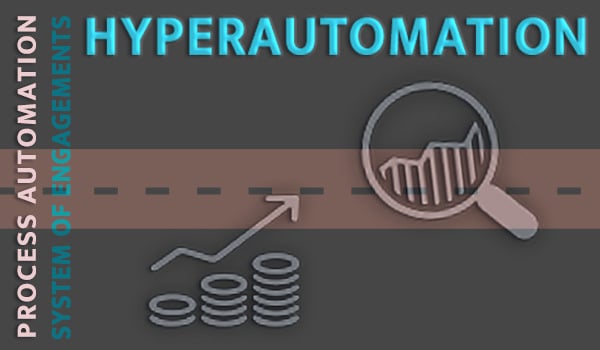
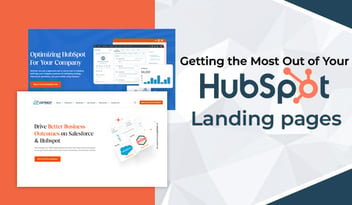
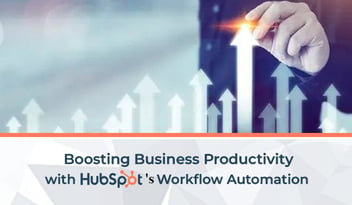
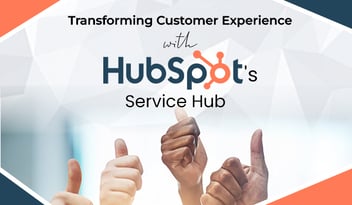
Leave a Comment